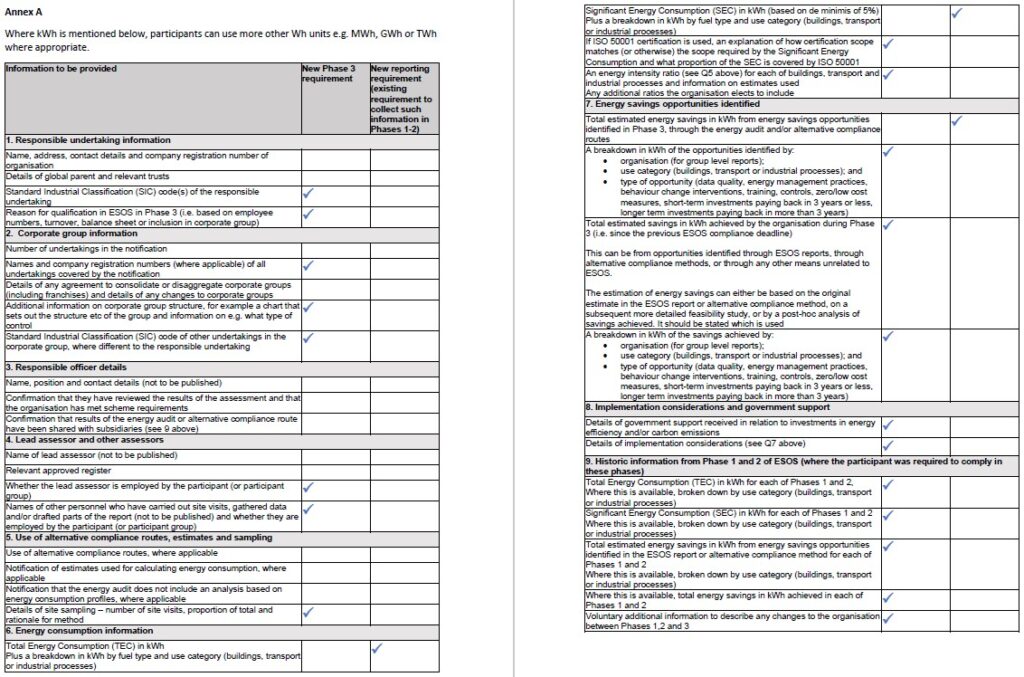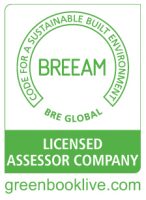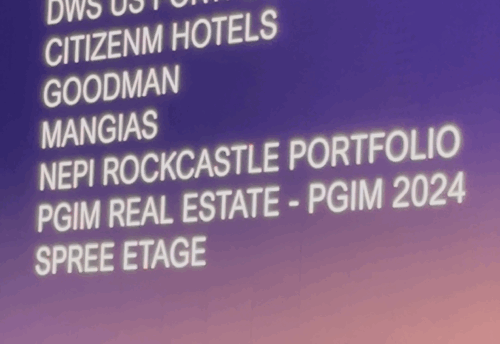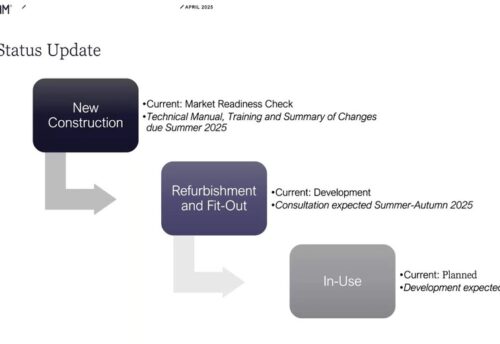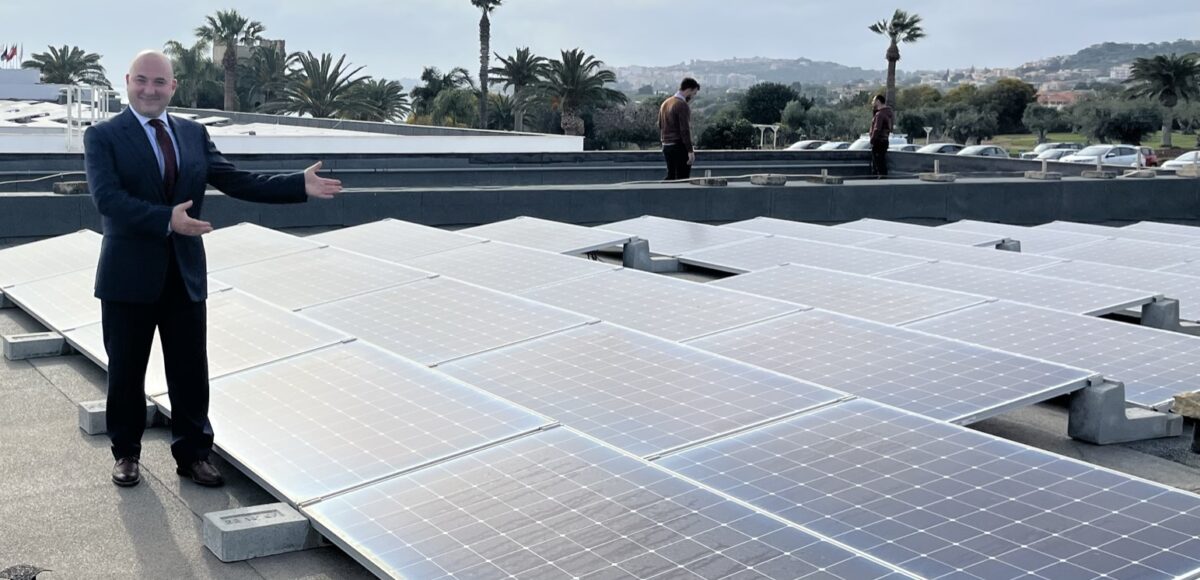
- May 24, 2023
ESOS Phase 3 important changes!
In this blog article we will be providing an update from the Department of Energy Security and Net Zero (formerly BEIS) on ESOS Phase 3 implementation. This is the legislation that transposed into UK law Article 8 of the Energy Efficiency Directive 2012/27/EU in 2014.
1. Phase 3 ESOS changes
Participants are still required to comply with Phase 3 of ESOS and Government still intend to make the changes announced in the government response to the ESOS consultation. The changes will be subject to legislative scrutiny and timetable, with the enabling primary legislation (The Energy Bill) currently passing through Parliament. Government will update participants when the Energy Bill has received Royal Assent, and the draft regulations are introduced to ensure there is a reasonable amount of time to meet the new requirements.
The changes set out in the government response for Phase 3 are:
-
- Requirement for a summary template to include compliance information in the ESOS report
-
- Requirement to submit additional data in the compliance notification (as set out in Annex A below)
-
- Requirement to include an energy intensity metric in ESOS reports
-
- A change to the de minimis exemption so that participants’ Significant Energy Consumption covers at least 95% of their Total Energy Consumption (as compared to 90% in Phase 2)
-
- Requirement for ESOS reports to provide more information on next steps for implementing recommendations
-
- Requirement for participants to set a target or action plan following the Phase 3 compliance deadline, on which they will be required to report against annually
-
- Requirement to share ESOS reports with subsidiaries
2. ESOS Guidance for Phase 3
Final guidance will be published on gov.uk once the new ESOS regulations have been laid in Parliament. This will happen after the Energy Bill, which contains the regulation making power, has been passed by Parliament. The Environment Agency / Department of Energy Security and Net Zero will issue newsletters and other communications before final publication of the guidance to make you aware of the changes to the scheme to enable quotations and to allow assessors to carry out assessments before the compliance deadline.
3. Summary report template for submitting reports to the Environment Agency.
A table is provided at Annex A setting out the information that will need to be notified to comply with the expected Phase 3 requirements, subject to Parliamentary approval of the legislation. Any specified format for providing the information in the table will be finalised and published once the new ESOS regulations are laid and details will be provided on how to submit the notification on the new digital service currently under development.
4. Notification for Phase 3
Notification cannot be submitted until the Phase 3 requirements have been finalised in legislation and the updated IT system which is currently being developed has been appropriately tested. The system will be made available in time to enable participants to meet notification requirements.
5. Metrics for ESOS reporting and how they relate to metrics required for Streamlined Energy and Carbon Reporting (SECR)
In the Government Response to the ESOS consultation it was stated that Government will require ESOS reports to include an overall energy intensity ratio in terms of kWh/m2 for buildings, kWh/unit output for industry and kWh/miles travelled for transport.
- For buildings, the metric should use Gross Internal Area (GIA).
- For transport the metric should use kWh/person mile for passenger transport and kWh/tonne mile for freight.
- For industrial processes the metric should be based on kWh per measure of production output. Use mass (ie kWh/tonne) if possible. Alternatively, if this is not an option you can use volume (ie kWh/litre) or unit (kWh/unit), whichever is the most relevant to the process.
- In addition, please provide a measurement of overall energy intensity in terms of turnover (ie kWh/£).
Government will provide more detailed guidance following legislation. Organisations may choose to provide additional metrics, for example providing a more detailed breakdown by fuel type. Organisations should bear in mind that whatever metric is chosen for Phase 3 should be reported against in future phases, as one of the purposes of the metric is to allow comparisons to be made between phases. If organisations need to use estimates to calculate metrics (for example to estimate missing floor area data or estimate the energy split between buildings and processes), details should be kept in the evidence pack. The intensity ratio required for SECR is a similar kind of metric as this compares emissions data with an appropriate business metric or financial indicator, such as square metres of floor space or sales revenue. However, the SECR metric relates to greenhouse gas emissions, while the ESOS energy intensity metric would relate to energy consumption.
6. Significant Energy Consumption (SEC) de minimis
You must calculate areas of SEC that cover at least 95% of a participant’s total energy consumption, rather than 90% as currently referred to in regulation 25 of the current ESOS Regulations. This is to reflect a reduction to the de minimis exemption from 10% to 5%. This change was set out in the Government Response to the ESOS consultation of 28 July 2022, but the final guidance will not be provided until the Parliamentary process for new ESOS regulations is complete.
7. Information requirements for next steps
When providing information on next steps (referred to as ‘implementation considerations’ in the table at Annex A), ESOS reports should cover considerations relating to how the opportunities identified could be implemented. ESOS reports should:
- provide an indicative programme of options which combines a selection of options recommended in the ESOS report and outlines the combined costs, benefits and payback period for the package
- suggest appropriate intervention points for any opportunity identified which is not suggested to be implemented immediately. This could be for example when renewing a transport/equipment lease or when replacing existing equipment
- signpost where buildings covered by the report are also covered by the Minimum Energy Efficiency Standards (MEES) for non-domestic buildings and whether this is relevant to the recommendations in the report (for example where there may be a requirement on landlords to carry out work that would affect a recommendation)
- provide information on government schemes which could support businesses to implement energy savings opportunities recommended in the report
Where relevant:
- include information on financing options to implement energy savings opportunities
- include information on how building, transport or equipment leases can affect an energy savings opportunity identified in the report
- provide detailed guidance on what actions to take next, where this is useful for the organisation e.g. what type of contractor, and terms of reference, might be required to implement recommendations.
This information is expected to be required for both participants that commission energy audits and those that use the alternative compliance routes. For participants using an alternative compliance route that do not have a dedicated ESOS report, this should be recorded in the evidence pack.
8. Action plans
The action plan does not need to be completed until after the compliance deadline and is expected to be required by December 2024. The details on how to complete the action plan will be published in final guidance on gov.uk once the new ESOS regulations have been laid in Parliament in advance of the Phase 3 compliance deadline.
9. ESOS reporting to subsidiaries
Where an ESOS participant is part of a corporate group, the ‘responsible undertaking’ that is responsible for ESOS compliance for that corporate group will be required to disseminate certain relevant information contained in the ESOS report, or the whole of the report, to subsidiary undertakings within the corporate group and to report that they have done so. There may be some cases where information in the ESOS report cannot be shared without breach of another legal obligation. Participants should seek their own advice as to whether this is the case and, if so, may be able to redact or summarise parts of the report so as to avoid such breaches. The information received by the subsidiary in relation to the ESOS report should be at a minimum:
- Details of any site visits, data gathered or energy consumption profiles specifically for that subsidiary
- Relevant energy savings opportunities for that subsidiary, either specifically or as part of a general recommendation across multiple parts of the organisation
- Costs and benefits of such opportunities
- Implementation considerations relevant to those opportunities (as set out in answer to Q8 about next steps)
10. PAS requirements for Phase 3
In the Government Response to the ESOS consultation it was set out that any net zero reporting would be voluntary for Phase 3. In the response Government outlined the intention to develop a PAS standard to cover the additional net zero requirement that is intended to be introduced for Phase 4 of ESOS and BSI, our partner organisation, consulted on this standard (PAS 51215-1) from 6 February to 20 March 2023. Using this PAS will not be required for Phase 3, though participants may use it on a voluntary basis.
Publishing the standard in 2023 is intended to give participants and ESOS laed assessors early sight of what the energy and net zero assessment will look like for ESOS Phase 4.
If you have any queries in relation to the Department of Energy Security and Net Zero update, please email businessenergyuse@beis.gov.uk.
If you have any queries relating to ESOS, please email esos@environment-agency.gov.uk or consult the ESOS guidance.
